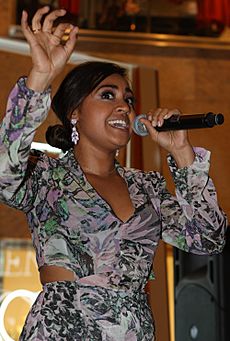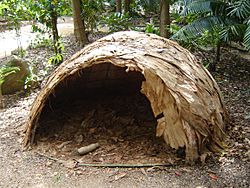Kuku Yalanji facts for kids


The Kuku Yalanji people, also known as Gugu-Yalanji or Kuku Yalandji, are an Aboriginal Australian group. They come from the beautiful rainforest areas of Far North Queensland.
Contents
The Guugu Yalandji Language
The Kuku Yalanji people have their own special language called Guugu Yalandji. Experts have studied it a lot. There is even a dictionary and a grammar book for it.
Traditional Lands
The Kuku Yalanji people traditionally lived on a large area of land. It was about 5,700 square kilometers (2,200 square miles). Their country was around the Palmer River in Queensland. It stretched from Palmerville station to Mount Lukin. Their lands also reached the Dividing Range and the upper Mitchell River. They lived as far east as Byerstown and were present at Maytown.
Kuku Yalanji People Today
Today, there are about 3,000 Kuku Yalanji people. They are known as one of the "Bama Rainforest Peoples." "Bama" means "people" in many Aboriginal languages. They are thought to be closely related to the Wulpura people. The Wulpura also live in the rainforest, near Mount Windsor National Park. Most Kuku Yalanji people now live in Mossman and Wujal Wujal.
History of Contact
White settlers began moving onto Kuku Yalanji lands in 1877. This happened after the government opened the area for new farms. Miners also rushed into the area. The Palmer River gold rush had started in 1873.
The Gold Rush
Within a year, over 5,000 Europeans and 2,000 Chinese people arrived. They came to the Palmer River area to find gold. Before this, only Kuku Yalanji people lived there. The Kuku Yalanji people resisted these new arrivals. A mission opened in 1886 on the Bloomfield River, but it closed after 16 years.
Forced Relocations
In the 1930s, some Kuku Yalanji people were forced to move. They were relocated to missions in Daintree and Mossman. Another attempt to move groups to a mission in Bloomfield happened in 1957.
The gold rush lasted from 1873 to 1885. At one point, there were about 17,000 Chinese people in the Palmer area. As the gold became harder to find, most Europeans left by 1880. The number of Chinese people also dropped to 3,000. The Kuku Yalanji people strongly resisted this invasion. They fought back in ways similar to guerilla warfare.
Life After Contact
Over time, the Kuku Yalanji people often ended up living in small settlements. These were usually on the edges of the new towns. They learned new skills to work in the changing economy.
From 1897 to the 1960s, the Kuku Yalanji faced government laws. These laws aimed to "protect" Aboriginal people. This often meant placing them on Aboriginal reserves. Many Kuku Yalanji gathered around the Mossman Reserve during World War II. People from the Daintree region were forced to move to the northern bank of the Daintree River. The government continued to relocate them.
Traditional Lifestyle
The Kuku Yalanji people lived by using the different seasons. It is thought they lived in the rainforest for at least 4,000 years. They had a high population for their time. They lived in semi-permanent homes called gunyahs.
Traditional Foods
Their main food for carbohydrates was the seeds of the Cycas media plant. These seeds are poisonous, but the Kuku Yalanji knew how to remove the poison before cooking them. They also ate two types of yam, especially the bitter yam (Dioscorea bulbifera). Other important foods included bitter walnut, candlenuts, and Kuranda quandong.
Seasons
The Kuku Yalanji people divided their year into five different seasons. This helped them know when to find certain foods.
Native Title Rights
The Kuku Yalanji people made a Native Title Claim in May 1995. This claim was for parts of their traditional land.
Recognition of Rights
In April 2007, the Eastern Kuku Yalanji people were recognized as the traditional owners of their land. This happened through 15 Indigenous Land Use Agreements (ILUAs). These agreements covered over 230,000 hectares (568,000 acres) between Mossman and Cooktown.
On October 19, 2007, these agreements were signed. About 64,000 hectares (158,000 acres) became freehold land. Some of this land was for conservation, and some for homes or businesses. The Eastern Kuku Yalanji people and the Queensland Parks and Wildlife Service (QPWS) now manage most of the land together.
On December 9, 2007, the Federal Court of Australia made a final decision. It recognized that the Eastern Kuku Yalanji People have exclusive native title rights over 30,300 hectares (74,900 acres) of state land. This means they can "possess, occupy and use the area to the exclusion of all others." They also have rights to pass on this land to future generations.
In other areas, about 96,600 hectares (238,700 acres), the Eastern Kuku Yalanji People have non-exclusive rights. These rights include hunting, camping, holding ceremonies, burials, and using water. The land is managed by the Jabalbina Yalanji Aboriginal Corporation. This group belongs to the Cape York Land Council.
Notable Kuku Yalanji Individuals
- Cathy Freeman, a famous athlete.
- Jessica Mauboy, an Australian R&B and pop singer.
- Pat O'Shane, a teacher, barrister, and activist. She was Australia's first Aboriginal magistrate.
- David Hudson, a musician and cultural educator.
- Tony Albert, an artist and co-founder of the artist group proppaNOW.
- Nathan Daly, a former rugby league and rugby union player. He is also an Aboriginal health coordinator. He has Kuku Yalanji and Torres Strait Islander heritage.


